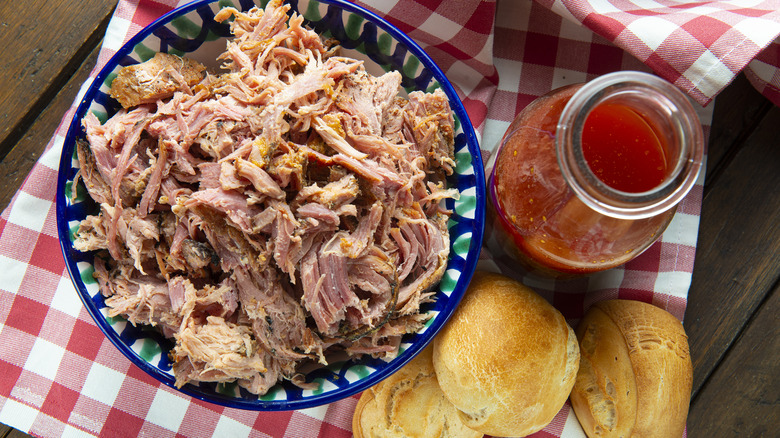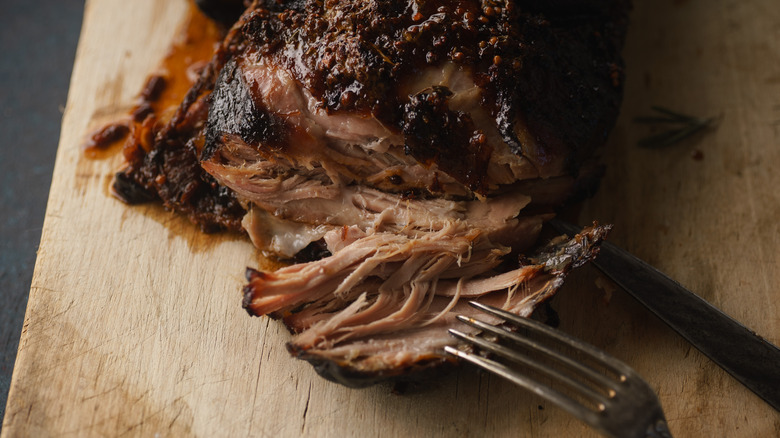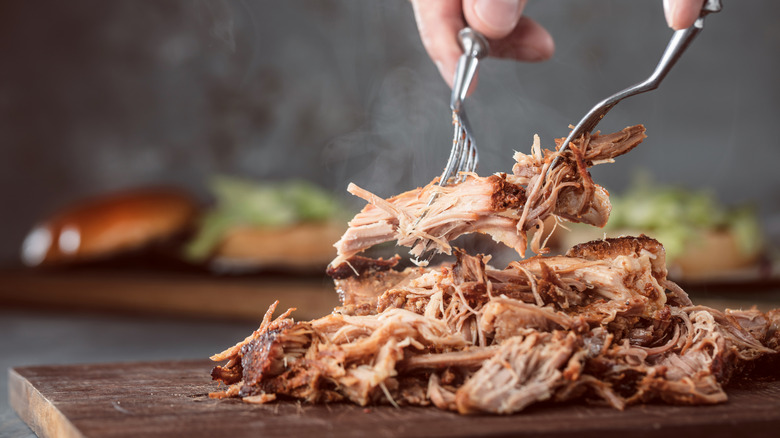Wondering How To Reheat Leftover Pulled Pork? Here's The Only Kitchen Appliance You Need
What do you think of when you think of summer? Corn on the cob? Hamburgers? Grilled chicken? While these are all good answers, there is one type of sandwich that joins the hamburger and hot dog as a summertime staple: pulled pork.
Pulled pork's popularity lies within two key factors: tenderness and flavor. Is there anything more satisfying than pulling apart a big hunk of pork that's so tender you could forgo the fork and tongs and just use your bare hands like some sort of caveman? What better complements a mound of juicy, melt-in-your-mouth pork than a big heaping glug of your favorite smokey barbeque sauce and a fresh bakery bun? Whether it's prepared at a roadside BBQ stand or in your own backyard, nothing quite says "cookout" like a messy, sloppy, and all-around delicious pulled pork sandwich. It's no wonder there's an actual honest-to-goodness day celebrating this porcine sandwich in October each year.
Although the pork may be tender and juicy the day you make it, chances are that it's nothing like that the next day. When you have a whole bunch of leftover pulled pork, you may find that it's become tough, stringy, and chewy. Nothing you do, from heating it in the microwave to putting it in the oven, seems to be able to bring back that tender, moist texture that the pork is so famous for.
Fortunately, one appliance — although not too fast — can help bring some life back into that pork: the slow cooker.
Put your pulled pork in your slow cooker
Your slow cooker isn't very fast. Heck, "slow" is smack-dab in the name. While it's true that you can't pop leftovers into it and expect them to be done in a few minutes like the microwave, the low-and-slow power of the slow cooker is just what you need if you ever want to enjoy leftover pulled pork that will taste almost as fresh and as tender as it did the first time.
To reheat leftover pulled pork in your slow cooker, fill the pot with whatever amount of pulled pork you want to reheat. If you have any pan drippings or juices, be sure to add that in too — if not, you could add your choice of barbeque sauce, stock, or marinade for the pork to saute in. Then, press the "warm" button on your slow cooker and allow it to sit. While this is a hands-free method of reheating your pork, keep in mind this can take two to four hours, depending on how much pork you're reheating. What's important is that you must make sure the meat reaches above or exactly the temperature of 165 degrees before you remove the pork from the slow cooker.
Unlike faster methods of reheating, like the microwave, the slow cooker applies constant gentle heat to the pork. This takes a while, true, but it also means that the pork is more likely to remain moist and tender rather than becoming incredibly tough and chewy.
You can also use your stovetop to reheat pulled pork
Let's say that you may not want to use your slow cooker because it takes too much time or maybe you just don't have a slow cooker to begin with. You can actually replicate the low, gentle heat of the slow cooker using your stove top– though, take note, this is a bit more hands-on than the "set it and forget it" method.
First, put a pan of your choice (such as stainless steel or cast iron pan) and allow it to sit over a burner set at medium-low heat. Once the pan is warm enough, you can add a cup of water, barbeque sauce, or stock to the pot and let it come to a simmer, where you will then reduce the heat to low. You can then add your pork to the simmering liquid, gently but continually stirring the meat in the liquid until it begins to soften up. Once the meat is soft, cover the pan and let it sit on the burner until the liquid begins to simmer again or the meat is at the appropriate 165 degrees.
While this is somewhat faster than the slow cooker method, this method requires you to pay a little more attention to just when to add the meat and when the meat will be done. It's about keeping the meat cooking at a slow but steady temperature to help maintain that juicy, moist, and tender texture it's famous for.


